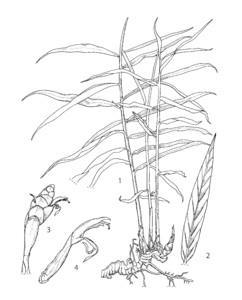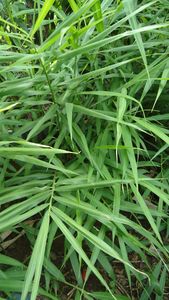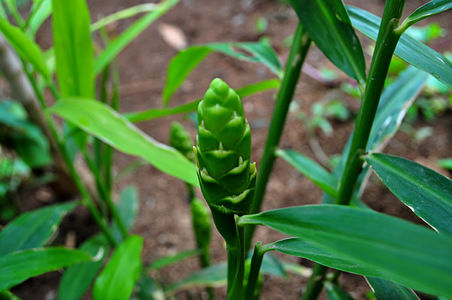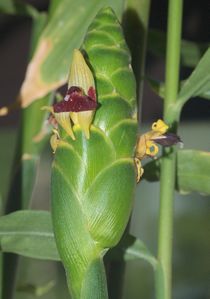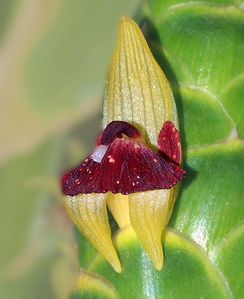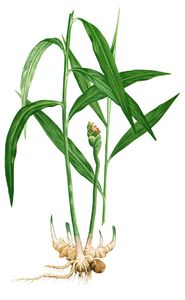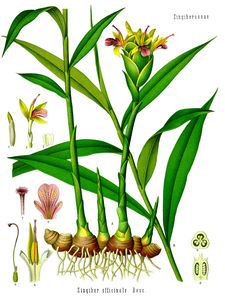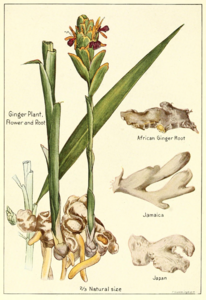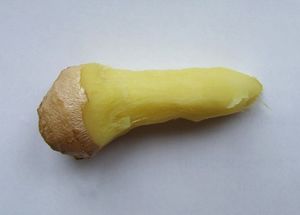Zingiber officinale
Zingiber officinale Roscoe
| Ordre | Zingiberales |
|---|---|
| Famille | Zingiberaceae |
| Genre | Zingiber |
2n = 22
Origine : Asie de l'Est
cultivé
| Français | gingembre |
|---|---|
| Anglais | ginger |
- rhizome : épice, boissons, médicinal
- rhizome utilisé frais, sec, mariné ou confit
- jeunes pousses : légume
Sommaire
Description
- rhizome ramifié, épais, charnu, jaune à l'intérieur, très aromatique
- pseudo-tiges stériles de 50-100 cm
- feuille sessiles, lancéolées, glabres, de 15-30 cm de long
- inflorescences naissant des rhizomes, ovoïdes, de 4-5 cm de long, bractées vert pâle
- corolle vert-jaune, lobe central du labelle à strie pourpre et taches crème
- fruit : capsule à 3 valves, s’ouvrant irrégulièrement
Noms populaires
| français | gingembre |
| créole guyanais | gingembre [jenjanm] (Pharma. Guyane) |
| palikur | isuu (Pharma. Guyane) |
| anglais | ginger |
| allemand | Ingwer : Ingber, Imber, Immerwurzel, Ingwerwurzel |
| néerlandais | gember |
| italien | zenzero |
| espagnol | jengibre ; kión |
| catalan | gingebre |
| portugais | gengibre ; mangarataia (nord Brésil) |
| grec | πιπερόριζα - piperoriza, τζίντζερ - tsitser |
| arabe | زنجبيل - zanǧabīl |
| chinois | 姜 - jiāng (Flora of China) |
| sanscrit | ardraka |
| hindi | ada ; अदरक - adrak (Flowers of India) |
| ourdou | ادرک - adrak, آدی - adi (Flowers of India) |
| bengali | আদা - ada (Flowers of India) |
| marathi | आले, सुंठ, alha, aale (Flowers of India) |
| gujerati | આદું - adu, સૂંઠ - sunth (Flowers of India) |
| telugu | allamu, sonthi (sec) ; అల్లపు - allam, చెట్టు - allamu, అల్లము - allamu chettu, శొంటి - shonti (Flowers of India) |
| tamoul | allam ; இஞ்சி - ingee, inji (Flowers of India) |
| kannada | hasisunti ; alla, shunthi (Flowers of India) |
| malayalam | andrakam ; ഇഞ്ചി - inchi, enchi (Flowers of India) |
| odia | ଅଦା - ada (Flowers of India) |
| manipuri | ꯁꯤꯡ - shing (Flowers of India) |
| népalais | अदुवा - aduwa (Flowers of India) |
| assamais | আদা - ada (Flowers of India) |
| tangkhul | hui (Flowers of India) |
| angami | kebvu, kevu (Flowers of India) |
| mizo | sawhthing (Flowers of India) |
| Philippines | luya (tagalog), baseng (ilocano), laya (bicol) (PROSEA) |
| Indonésie | jahe, jae, lia (PROSEA) |
| Malaysia | haliya, jahi, atuja (PROSEA) |
| Papouasie-Nouvelle-Guinée | kawawar, kawawari (PROSEA) |
| Thaïlande | khing, khing-daeng (PROSEA) |
| Vietnam | gừng, sinh khương (PROSEA) |
| Laos | khi:ng (PROSEA) |
| Cambodge | khnhei, khnhei phlung (PROSEA) |
| Birmanie | gyin (PROSEA) |
- Voir l'étymologie de Zingiber
Classification
Zingiber officinale Roscoe (1807)
synonyme :
- Amomum zingiber L. (1753)
Cultivars
Histoire
Michał Boym, 1656. Flora Sinensis
Usages
Un usage particulier consiste à introduire dans l'anus ou le vagin d'une personne ou d'un animal un morceau de rhizome pelé, à titre de punition. Cela s'appelle figging en anglais.
Cet usage est aussi mentionné pour les maquignons qui veulent donner plus de vigueur à un cheval de peu de valeur. Eugène Rolland le signale avec une racine de jusquiame.
- Voir les Plantes médicinales du Cambodge, du Laos et du Viêtnam de Petelot (1952-1954)
- Voir la composition nutritionnelle:
- du gingembre moulu (Table CIQUAL),
- du gingembre moulu (National Nutrient Database for Standard Reference (USDA))
- et du gingembre frais (National Nutrient Database for Standard Reference (USDA)).
In the tropical region widely cultivated (S, SE and E Asia, Australia, Australasia, Africa, Central America, northern South America). Major exporting countries: India, W Malaysia, and Nigeria. The rhizomes are the source of an important spice. The very young rhizomes (green ginger) are peeled and eaten raw or boiled preserved in syrup or candied. The sweetened ginger rhizomes are also utilized to flavour chocolate, jam, and cakes; the syrup is used in sauces, pickles, and ginger bread. The rhizomes are also sold dried. The fresh ginger rhizomes are a condiment in curries and chutneys. The mature rhizomes are blanched and scraped (white ginger) or blanched only (black ginger). The ground ginger is a condiment in curry powder. The rhizomes are also used to produce ginger beer and ginger ale. The Arabs mix the coffee with an ginger extract. The ginger oil, an essential oil obtained from the fresh unscraped rhizomes by distillation, serves as a flavouring in sweets, sauces, cakes, ice-cream, meat products, and beverages (liqueur, wine, brandy). Similar purposes serves the ginger oleoresin, obtained by extraction. The rhizomes are also used medicinally, (officinal: Rhizoma Zingiberis; unscraped: Rhizoma Zingiberis nigrum). The young shoots are eaten as a potherb. The ginger had been cultivated in India and China already since ancient times. By trade the dried rhizomes reached the Mediterranean area early and were used by Greeks and Romans. Also in the Middle Ages the ginger had been an important spice in Europe. In the 13th cent. the species arrived E Africa by the Arabs and in the 16th cent. W Africa by the Portuguese. The Spaniards brougth the ginger to the Westindies in the 16th cent., from where the product had been exported on a large scale to Spain.
Références
- Boym, Michał, 1696. Flora Sinensis. Paris, 15 p. Seconde édition en français. Voir Sem-kiam sur Pl@ntUse.
- Chauvet, Michel, 2018. Encyclopédie des plantes alimentaires. Paris, Belin. 880 p. (p. 791)
- Elevitch, Craig (ed.), 2011. Specialty Crops for Pacific Islands: horticulture, value-added processing, and marketing. Holualoa, Hawai'i, Permanent Agriculture Resources. 576 p., 940 photos. Agroforestry télécharger le pdf
- Grenand, Pierre ; Moretti, Christian ; Jacquemin, Henri & Prévost, Marie-Françoise, 2004. Pharmacopées traditionnelles en Guyane. Créoles, Wayãpi, Palikur. 2e édition revue et complétée. Paris, IRD. 816 p. (1ère éd.: 1987). Voir sur Pl@ntUse.
- TRAMIL, Pharmacopée végétale caribéenne, éd. scient. L. Germosén-Robineau. 2014. 3e éd. Santo Domingo, Canopé de Guadeloupe. 420 p. Voir sur Pl@ntUse
Liens
- BHL
- Flora of China
- Flora of Pakistan
- Flowers of India
- Gernot Katzer's Spice pages
- Grieve's herbal
- GRIN
- IPNI
- Mansfeld
- Médiathèque Caraïbe (Laméca)
- Medicinal plants and herbs (Steven Foster)
- Multilingual Plant Name Database
- NewCrop Purdue
- Passeport santé
- Plant List
- Plants of the World Online
- PROSEA sur Pl@ntUse
- TAXREF
- Tela Botanica
- Wikipédia
- Wikiphyto
- World Flora Online

